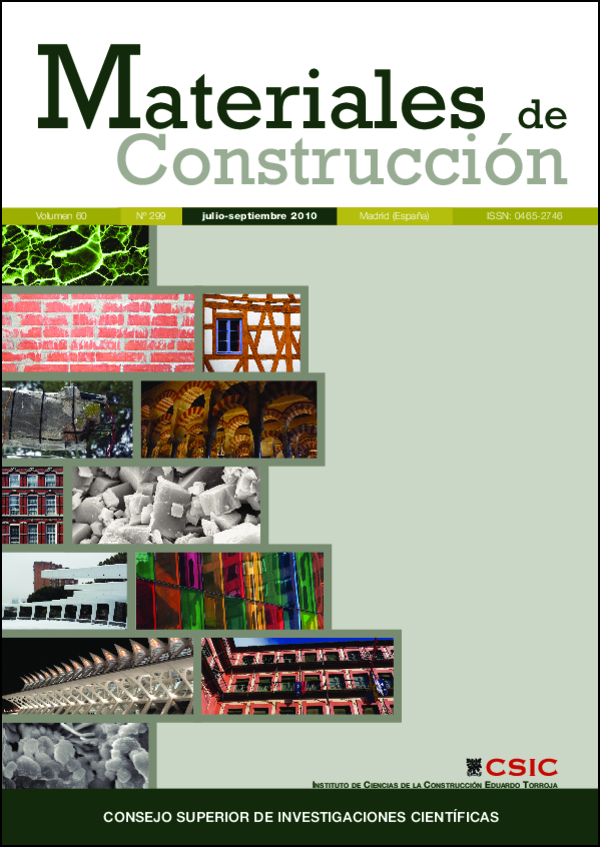The alkali–aggregate reaction for various aggregates used in concrete
DOI:
https://doi.org/10.3989/mc.2010.48708Keywords:
alkali–silica reaction, degradation, expansion, mortar, SEMAbstract
The aim of this work is to contribute to the knowledge of the interactions between aggregates and the components of the interstitial phase of concrete and to determine whether those aggregates that are subsequently used in the manufacture of concrete are reagents and are therefore likely to undergo a progressive deterioration of their initial properties. An initial petrographic study of each aggregate is performed in order to be able to determine its subsequent behaviour and reactivity under the influence of various factors. The potential reactivity of different silicaceous aggregates (slates, gneiss, hornfels, granites, quartzite and serpentine) is then determined by a chemical method for evaluating the potential reactivity of aggregates and an accelerated method in mortar specimens, and finally the surface reactivity is investigated. The results of these studies suggest that some aggregates are able to react with the components of the interstitial phase of concrete. The existence of this kind of interaction is confirmed by the results of the surface investigations before and after the basic reaction.
Downloads
References
(1) Menéndez, E.; Soriano, J.: “Procesos expansivos del hormigón: ensayos árido-álcali, ataque por sulfatos, hielo deshielo. Sistemas de prevención y actuaciones” (CEMCO) (2007).
(2) Rear, K.; Meinheit, D. F.: “Alkali-aggregate reactivity. A summary”. PCI Committee on Durability, PCI Journal, Nov-Dec 1994.
(3) Dent Glasser, L. S.; Kataoka, N.: “The chemistry of alkali-aggregate reaction”, Cem. Concr. Res., 11 (1981), 1-9. doi:10.1016/0008-8846(81)90003-X
(4) Glasser, F. P.: “Chemistry of the alkali–aggregate reaction”, in: R. N. Swamy (ed.), The Alkali Silica Reaction in Concrete, Blackie and Son Ltd., Glasgow, UK (1992), pp. 30-53.
(5) Soriano, J.: “Influencia de la naturaleza mineralógica de las adiciones en el comportamiento de la pasta endurecida de cemento Pórtland”, Revista de Obras Públicas (1981).
(6) Stanton, T. E.: “A study of alkali-aggregate reactivity”, Proc. Amer. Soc. Civ. Eng., vol. 66 (1940), pp. 1781-1792.
(7) Menéndez, E.: “Deterioro de materiales artificiales I. Reacción álcali-árido”. La humedad como patología frecuente en la edificación. Ed. Colegio Oficial de Aparejadores y Arquitectos Técnicos de Madrid (1993).
(8) Hobbs, D. W.: “Alkali-silica reaction in concrete”. Ed. Thomas Telford, London (1988).
(9) Soriano, J.; Riesgo, L.: “Áridos reactivos”. Revista de Obras Públicas, 967-972, 1984.
(10) Soriano, J.: “Influencia de la naturaleza mineralógica de las adiciones en el comportamiento de la pasta endurecida de cemento Pórtland”, Revista de Obras Públicas (1981).
(11) Puertas, F.; Gutiérrez, R.; Fernández, A.; Delvasto, S.; Maldonado, J. “Alkaline cement mortars: chemical resistance to sulfate and seawater attack”, Mater Construcc., vol. 267 (2002), pp. 55-72. doi:10.3989/mc.2002.v52.i267.326
(12) Norma UNE 146507-1 “Método químico para la determinación de la reactividad potencial de áridos”.
(13) Durand, B.; Berard, J.; Roux, R.; Soles, J. A.: “Alkali-silica reaction: the relation between pore solution characteristics and expansion test results”, Cem. Concr. Res. 20 (1990), pp. 419-428. doi:10.1016/0008-8846(90)90032-S
(14) Norma UNE 146508:99 EX “Método acelerado en probetas de mortero”.
(15) ASTM C 1260-94, Standard test method for potential alkali reactivity of aggregates (mortar-bar method), Annual Book of ASTM Standards v. 04.02, Concrete and Aggregates, American Society for Testing and Materials, Philadelphia (1999), pp. 650-653.
(16) Yi, C. K.; Ostertag, C. P.: “Mechanical approach in mitigating alkali-silica reaction” Cem. Concr. Res., 35 (2005), pp. 67-75. doi:10.1016/j.cemconres.2004.02.017
(17) Clayton, N.: “The effects of alkali silica reaction on the strength of pre-stressed concrete beams”, Struct. Engr. 68 (1990), pp. 287-292.
(18) McGowan, J. K.; Vivian, H. E.: “Studies in cement-aggregate reaction, XXIII: The effect of superincumbent load on mortar bar expansion”, Aust. J. Appl. Sci. 5 (1954), pp. 94-97.
(19) Ben Haha, M.; Gallucci, E.; Guidoum, A.; Scrivener, K. L.: “Relation of expansion due to alkali silica reaction to the degree of reaction measured by SEM image analysis”, Cem. Concr. Res, 37 (2007), pp. 1206-1214. doi:10.1016/j.cemconres.2007.04.016
(20) Aardt, J. H. P. and Visser, S.: “Formation of hydrogarbets: calcium hydroxide attack on clays and feldespars”, Cem. Concr. Res., vol. 7 (1977), pp. 39-44. doi:10.1016/0008-8846(77)90006-0
(21) Aardt, J. P. H.; Visser, S.: “Calcium hydroxide attack on feldspars and clays: possible relevance to cement aggregated reactions”, Cem. Concr. Res., 7 (1977), pp. 643-648. doi:10.1016/0008-8846(77)90046-1
(22) Way, S. J.; Cole, W. F.: “Calcium hydroxide attack on rocks”, Cem. Concr. Res., 12 (1982), pp. 611-617. doi:10.1016/0008-8846(82)90022-9
Downloads
Published
How to Cite
Issue
Section
License
Copyright (c) 2010 Consejo Superior de Investigaciones Científicas (CSIC)

This work is licensed under a Creative Commons Attribution 4.0 International License.
© CSIC. Manuscripts published in both the printed and online versions of this Journal are the property of Consejo Superior de Investigaciones Científicas, and quoting this source is a requirement for any partial or full reproduction.All contents of this electronic edition, except where otherwise noted, are distributed under a “Creative Commons Attribution 4.0 International” (CC BY 4.0) License. You may read here the basic information and the legal text of the license. The indication of the CC BY 4.0 License must be expressly stated in this way when necessary.
Self-archiving in repositories, personal webpages or similar, of any version other than the published by the Editor, is not allowed.


















